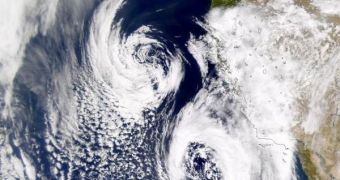Though our ears are too insensitive to perceive it, the planet is constantly generating a low-frequency humming noise, which was first discovered with instruments in 1998. At a frequency of around 10 millihertz, the sound is far outside our hearing range, as we can only perceive sounds as low as 20 hertz. Now, scientists have finally been able to determine the source of the humming noise, and also the regions where it can be heard most loudly. The find puts an end to rumors and conspiracy theories about some unnatural event that may be causing the hum.
According to a group of researchers, the noise is created by nothing more than waves, albeit not the kind that hit the shorelines around the globe everyday. Some scientists argued ever since the phenomenon was first discovered that sea waves colliding with the ocean floor might be the trigger behind it. Now, in a scientific study published last Thursday in the respected scientific journal Geophysical Research Letters, the experts show that the Pacific Coast of North America is the strongest source for the hum.
The sound is produced as two waves, of similar frequencies, but opposite directions, meet. They collide with each other and generate a very special type of pressure wave, which travels downward towards the ocean floor at fairly large speeds. When it reaches the bottom, it slams into the rocks, causing it to vibrate, and give off the mysterious, low-frequency sound. The hum sounds to us as being generated non-stop because it happens in a lot of places around the world, and because waves of opposite directions always interact with each other.
The new research was made possible by the fact that seismographs can easily detect this low noise. Using an array of scientific data collected from such an instrument, called the USArray EarthScope, the science team was able to infer that the west coast of Europe also generates a significant hum of its own. Oddly enough, they say, there was little noise recorded as coming from the deep sea, which seems to indicate that the humming occurs mostly near coastal areas, where the seafloor is much more close to the surface than in the deep sea.
The investigation used scientific data collected between November 2006 and June 2007, so the experts believe it may be possible that the actual patterns vary with seasons. A study spanning several years is in order, if the noises' patterns and origins are to be accurately identified, Wired informs.

 14 DAY TRIAL //
14 DAY TRIAL //